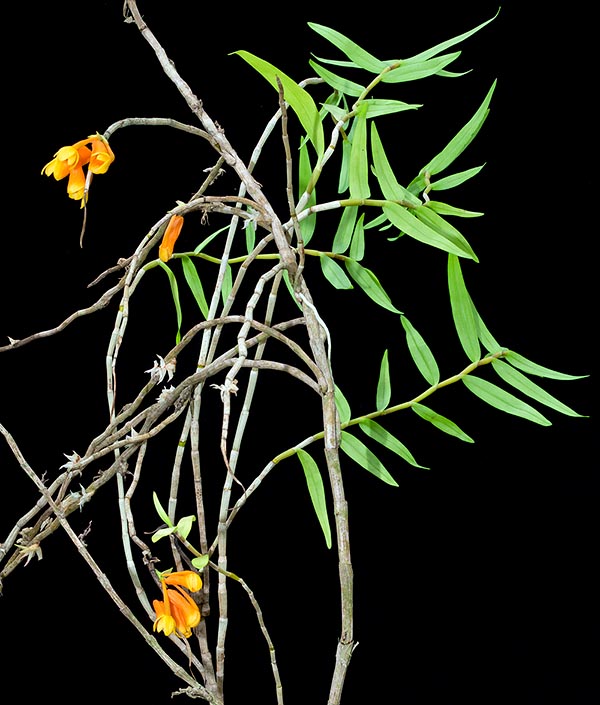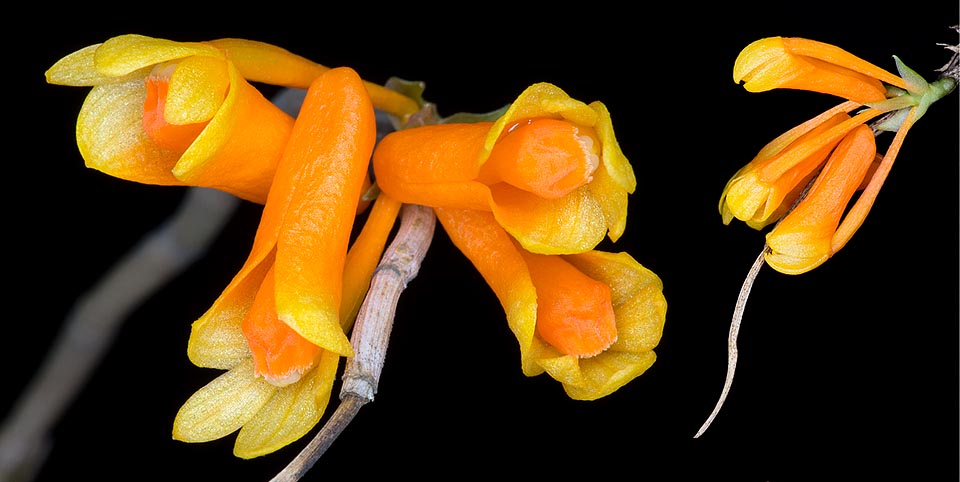Family : Orchidaceae

Text © Pietro Puccio

English translation by Mario Beltramini

The Dendrobium subclausum is a Moluccas and New Guinea epiphyte or lithophyte with stems at times ramified, thin, lithe, erect or semi-drooping, up to more than 60 cm long, with 2,5-6 cm leaves © Mazza
The name of the genus is the combination of the Geek substantives “δένδρον” (dendron) = tree and “βίος” (bios) = life, with reference to the numerous species of the genus living on the trees; the specific name is the combination of the Latin prefix “sub” = under, about and of the adjective “clausus, a, um” = closed, with reference to the not completely open flowers.
The Dendrobium subclausum Rolfe (1894) is an epiphytic or lithophytic species with stems at times ramified, thin, lithe, erect or semi-drooping, up to more than 60 cm long, provided of lanceolate leaves with pointed apex, 2,5-6 cm long and 0,3-1 cm broad, of intense green colour at times suffused of dark purple if in particularly luminous position. Inflorescences, on the old pseudobulbs, compact, 1,3 cm long, bearing up to 8 flowers, 2,5 cm long and of about 1 cm of diameter, of orange or bright orange red colour. Clavate ovarium about 2 cm long, ovate dorsal sepal 0,5 cm long and 0,4 cm broad, triangular lateral sepals of the same length as the dorsal merged at the base to form a sort of spur (mentum) 1,4 cm long, elliptic-spatulate petals slightly shorter than the sepals, labellum cucullate (shaped like a hood) bent upward with toothed margin, 1,3 cm long.
It reproduces by seed, in vitro, and by division, with each section provided of at least 3-4 pseudobulbs.
Floriferous miniature orchid with long lasting flowers and bright colour, requires a slightly shaded exposition, medium temperatures, 18-26 °C in summer, 12-18 °C in winter, high humidity, 70-85%, and constant ventilation. The waterings must be regular and abundant during the growth, reduced in winter, but without ever letting dry for long periods, till the vegetative restart, utilizing rain water, demineralized or by reverse osmosis. Cultivable in pot or baskets with draining compost that can be formed by medium sliced bark fragments and sphagnum, with possible addition of inerts to improve the drainage, or can be mounted on branches or bark with sphagnum at the base. Repottings and transplants are to be done at the vegetative restart.
The flowers are locally utilized for adorning the hairs.

The inflorescences, seen here from below and side, grow compact on the old pseudobulbs with even 8 flowers 2,5 cm long and of about 1 cm of diameter © G. Mazza
Synonyms: Dendrobium mitriferum J.J.Sm. (1910); Dendrobium flammula Schltr. (1912); Dendrobium mitriferum f. alpinum J.J.Sm. (1916); Dendrobium strictum Ridl. (1916); Dendrobium lane-poolei R.S.Rogers (1925); Dendrobium asumburu P.Royen (1979); Dendrobium aurantiflavum P.Royen (1979); Pedilonum flammula (Schltr.) Rauschert (1983); Pedilonum mitriferum (J.J.Sm.) Rauschert (1983); Pedilonum strictum (Ridl.) Rauschert (1983); Pedilonum subclausum (Rolfe) Rauschert (1983); Chromatotriccum asumburu (P.Royen) M.A.Clem. & D.L.Jones (2002); Chromatotriccum aurantiflavum (P.Royen) M.A.Clem. & D.L.Jones (2002); Chromatotriccum flammula (Schltr.) M.A.Clem. & D.L.Jones (2002); Chromatotriccum lane-poolei (R.S.Rogers) M.A.Clem. & D.L.Jones (2002); Chromatotriccum mitriferum (J.J.Sm.) M.A.Clem. & D.L.Jones (2002); Chromatotriccum strictum (Ridl.) M.A.Clem. & D.L.Jones (2002); Chromatotriccum subclausum (Rolfe) M.A.Clem. & D.L.Jones (2002).
→ For general notions about ORCHIDACEAE please click here.
